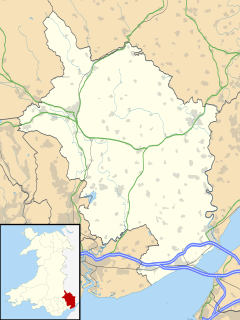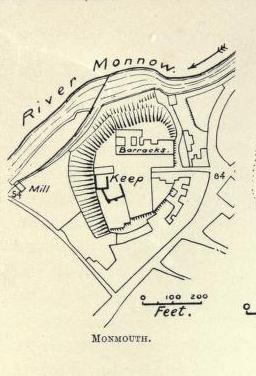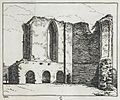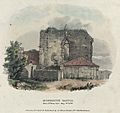Monmouth Castle facts for kids
Quick facts for kids Monmouth Castle |
|
|---|---|
| Castell Trefynwy | |
| Monmouth, Wales | |
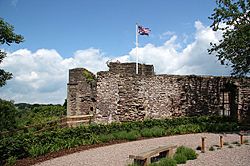
Ruins of the castle
|
|
| Coordinates | 51°48′45″N 2°43′00″W / 51.8125°N 2.7167°W |
| Site information | |
| Condition | Ruin |
| Site history | |
| Built | 1067 |
| Built by | William FitzOsbern, 1st Earl of Hereford |
Monmouth Castle (Welsh: Castell Trefynwy) is an old castle in the town of Monmouth, in southeast Wales. It's a very important historic site, listed as a Grade I building and a scheduled monument. You can find it near the center of Monmouth town, on a hill overlooking the River Monnow.
This castle was once very important for guarding the border between England and Wales. It's also famous as the birthplace of Henry V of England, a well-known king. During the English Civil War, the castle was badly damaged. It changed hands three times before being partly destroyed on purpose. This was done to stop anyone from using it as a fort again. After part of it fell down in 1647, a new building called Great Castle House was built there. Today, this house is the main office and museum for the Royal Monmouthshire Royal Engineers, a military group.
Contents
Building a Norman Border Castle
Right after the Normans took over England, William the Conqueror gave land to three of his most trusted friends. These friends became Earls of Chester, Shrewsbury, and Hereford. Their job was to protect the border with Wales and help with the Norman invasion of Wales. Over the next 400 years, Norman lords built many small castles along the border. These lords were like military adventurers. They would take over an area in Wales, build a fort, and then give land to their supporters.
William FitzOsbern's Castle
William FitzOsbern, 1st Earl of Hereford built Monmouth Castle between 1066 and 1069. It was similar to his other big castle at Chepstow Castle. Monmouth Castle was built on high ground, where the Monnow River meets the River Wye.
At first, it was a simple fort made of earth and wood. This early castle was even mentioned in the Domesday Book, a famous survey from 1086. Monmouth was a typical border castle in the Welsh Marches, an area along the Welsh border. It was like other nearby castles such as Grosmont Castle and White Castle. Before 1150, stone parts were added to the wooden castle. Its main tower looks a bit like the one at Chepstow Castle.
Castle Growth and Royal Connections
After a short time, Simon de Montfort, 6th Earl of Leicester owned Monmouth Castle. Then, in 1267, it went to Edmund Crouchback, who was the son of Henry III of England. Edmund made the castle bigger and built a large hall. He used it as his main home in the area.
Improvements and Royal Birth
The castle was improved even more in the early 1300s. This was probably done by Edmund's grandson, Henry of Grosmont, 1st Duke of Lancaster. During this time, big, fancy windows were added to the Great Tower. The tower also got a new roof. As a town grew around the castle, new defenses were added. These included a town wall and a fortified bridge built in the late 1200s.
Edward II of England was held prisoner in the castle for a short time. He was later moved to Berkeley Castle, where he died. Monmouth Castle was a favorite place for Henry Bolingbroke, who later became King Henry IV. It was here, in 1387, that his first wife, Mary de Bohun, gave birth to their son. This son would later become the famous King Henry V of England.
The Glyndŵr Rebellion
Wales faced a lot of fighting during the Owain Glyndŵr rebellion, which lasted ten years. Monmouth Castle was a strong fort, so it wasn't directly attacked. Instead, Glyndŵr's army, which fought like guerrillas, attacked easier targets. Other towns and castles nearby were attacked. For example, Grosmont and Abergavenny were destroyed. Crickhowell Castle and Newport Castle were also successfully attacked.
Over time, the castle's role as a defense became less important. The outer part of the castle, called the bailey, started to be used as a market. Today, this area is known as Agincourt Square. In the 1500s, Monmouth became the main town of the new county of Monmouthshire. The county's law courts then began to meet in the castle's Great Hall.
The English Civil War and Beyond
During the English Civil War, Monmouth Castle was fought over many times. It changed hands three times. Finally, in 1645, the Parliamentarian army, also known as the Roundheads, took control. When Oliver Cromwell visited in 1646, he ordered the castle to be partly destroyed. This was to stop anyone from using it for military purposes again.
Castle's Collapse
The round tower of the castle was attacked on March 30, 1647. It later fell down. A diary from that time, now lost, recorded the collapse on December 22, 1647. It said that the tower fell around noon while people were at church. Later, in the late 1700s, a visitor named William Gilpin described the castle's sad state. He said it was once a king's palace and the birthplace of a great prince. But by then, it was just a yard for "fatting ducks."
Great Castle House was built in 1673. It stands where the old round tower used to be. Henry Somerset, 1st Duke of Beaufort built it. It's a Grade I listed building and is known for its grand look. This house was also used for law courts until a new building, Shire Hall, was built in 1725.
Monmouth Castle Today
Today, only parts of the castle remain above ground. These include fragments of the Great Tower and Hall, and some walls. Castle House and Great Castle House have been built on the old castle site.
Military Headquarters and Museum
In 1875, the Royal Monmouthshire Royal Engineers Militia made the castle site their main office. This group is now the oldest Territorial Army regiment. It is one of the few British castles that is still used by the military today.
The Royal Monmouthshire Royal Engineers museum is located in the stable building next to Great Castle House. It shows the history of the regiment from 1539 to the present day. Monmouth Castle is a Grade I listed building and a scheduled monument. It is looked after by Cadw, the Welsh government's historic environment service.
Gallery
-
Monmouth Castle and St Mary's Priory Church in 1800.
See also
 In Spanish: Castillo de Monmouth para niños
In Spanish: Castillo de Monmouth para niños


